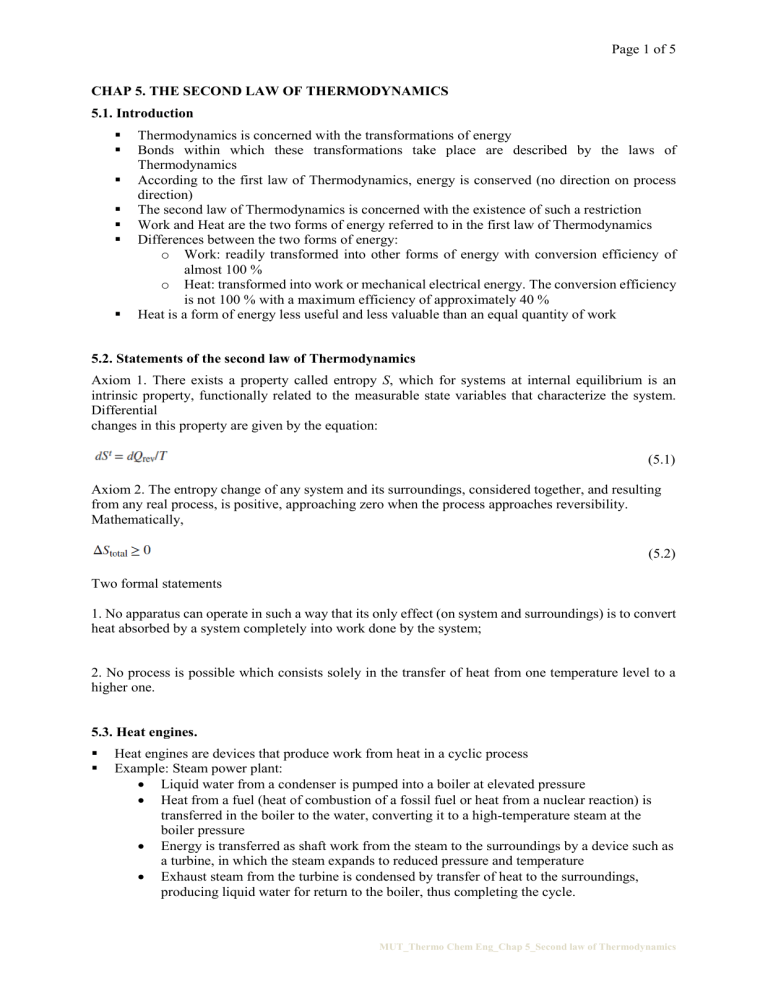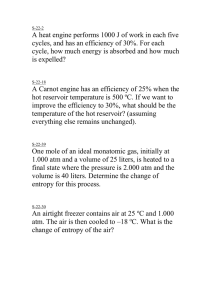
Page 1 of 5 CHAP 5. THE SECOND LAW OF THERMODYNAMICS 5.1. Introduction Thermodynamics is concerned with the transformations of energy Bonds within which these transformations take place are described by the laws of Thermodynamics According to the first law of Thermodynamics, energy is conserved (no direction on process direction) The second law of Thermodynamics is concerned with the existence of such a restriction Work and Heat are the two forms of energy referred to in the first law of Thermodynamics Differences between the two forms of energy: o Work: readily transformed into other forms of energy with conversion efficiency of almost 100 % o Heat: transformed into work or mechanical electrical energy. The conversion efficiency is not 100 % with a maximum efficiency of approximately 40 % Heat is a form of energy less useful and less valuable than an equal quantity of work 5.2. Statements of the second law of Thermodynamics Axiom 1. There exists a property called entropy S, which for systems at internal equilibrium is an intrinsic property, functionally related to the measurable state variables that characterize the system. Differential changes in this property are given by the equation: (5.1) Axiom 2. The entropy change of any system and its surroundings, considered together, and resulting from any real process, is positive, approaching zero when the process approaches reversibility. Mathematically, (5.2) Two formal statements 1. No apparatus can operate in such a way that its only effect (on system and surroundings) is to convert heat absorbed by a system completely into work done by the system; 2. No process is possible which consists solely in the transfer of heat from one temperature level to a higher one. 5.3. Heat engines. Heat engines are devices that produce work from heat in a cyclic process Example: Steam power plant: Liquid water from a condenser is pumped into a boiler at elevated pressure Heat from a fuel (heat of combustion of a fossil fuel or heat from a nuclear reaction) is transferred in the boiler to the water, converting it to a high-temperature steam at the boiler pressure Energy is transferred as shaft work from the steam to the surroundings by a device such as a turbine, in which the steam expands to reduced pressure and temperature Exhaust steam from the turbine is condensed by transfer of heat to the surroundings, producing liquid water for return to the boiler, thus completing the cycle. MUT_Thermo Chem Eng_Chap 5_Second law of Thermodynamics Page 2 of 5 Heat reservoir: it is a body imagined capable of absorbing or rejecting unlimited quantities of heat without temperature change Figure 5.1. Carnot engine and heat pump QH: Heat absorbed from the hot reservoir QC: Heat rejected to the cold reservoir W: amount of work produced From first law: (5.3) The thermal efficiency of the engine is defined as: W QH QC net work output (5.4) heat absorbed W Q QC Q H 1 C QH QH QH (5.5) For η=1 (100 % efficiency), QC would be 0. This is practically impossible. Carnot engine: a special case where the heat engine operates in a completely reversible manner. The following steps make up the cycle of any Carnot engine: ∙ Step 1: A system at an initial temperature of a cold reservoir at TC undergoes a reversible adiabatic process that causes its temperature to rise to that of a hot reservoir at T H. ∙ Step 2: The system maintains contact with the hot reservoir at TH and undergoes a reversible isothermal process during which heat QH is absorbed from the hot reservoir. ∙ Step 3: The system undergoes a reversible adiabatic process in the opposite direction of Step 1 that brings its temperature back to that of the cold reservoir at TC. ∙ Step 4: The system maintains contact with the reservoir at TC, and undergoes a reversible isothermal process in the opposite direction of Step 2 that returns it to its initial state with rejection of heat QC to the cold reservoir. MUT_Thermo Chem Eng_Chap 5_Second law of Thermodynamics Page 3 of 5 Note: . Its efficiency depends only on the temperature levels and not upon the working substance of the engine. ∙ For two given heat reservoirs no engine can have a thermal efficiency higher than that of a Carnot engine. Carnot engine: All heat absorbed is transferred at the constant temperature of the hot reservoir and all heat rejected is transferred at the constant temperature of the cold reservoir Carnot’s theorem: For two given heat reservoirs, no engine can have a thermal efficiency greater than that of a Carnot engine. The thermal efficiency of a Carnot engine depends only on the temperature levels and not upon the working substance of the engine. 5.4. Thermodynamic temperature scales *Ideal gas temperature scale. The cycle traversed by a working fluid in its ideal-gas state in a Carnot engine is shown on a PV diagram in Fig. 5.2. It consists of four reversible processes corresponding to Steps 1 through 4 of the general Carnot cycle described in the preceding section: ∙ a → b Adiabatic compression with temperature rising from TC to TH. ∙ b → c Isothermal expansion to arbitrary point c with absorption of heat |QH|. ∙ c → d Adiabatic expansion with temperature decreasing to TC. ∙ d → a Isothermal compression to the initial state with rejection of heat |QC|. Figure 5.2. PV diagram showing Carnot cycle for an ideal gas In this analysis the ideal-gas-state working fluid is regarded as the system. For the isothermal steps b → c and d → a, from the following equation: (5.6) It follows that: MUT_Thermo Chem Eng_Chap 5_Second law of Thermodynamics Page 4 of 5 And finally, QH QC TH TC W QH 1 (5.7) TC TH (5.8) 5.5. Entropy 5.5.1. Definition For a reversible process, the change of entropy is given by (5.1) S dQrev T (5.9) From equation (5.2), it can be stated that entropy is the measure of the degree of disorder of a system. The greater the disorder the higher the entropy. 5.5.2. Entropy changes for an ideal gas MUT_Thermo Chem Eng_Chap 5_Second law of Thermodynamics Page 5 of 5 Worked example MUT_Thermo Chem Eng_Chap 5_Second law of Thermodynamics




